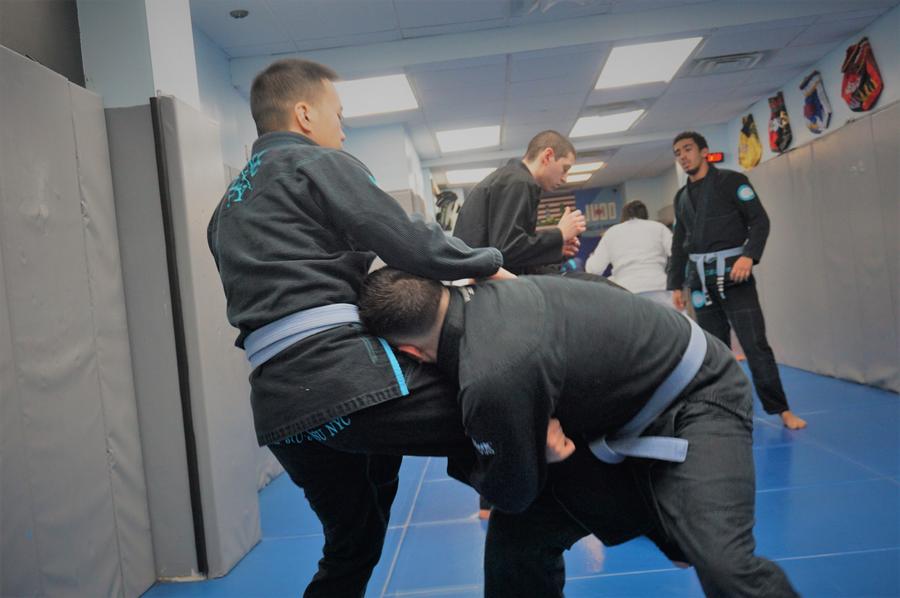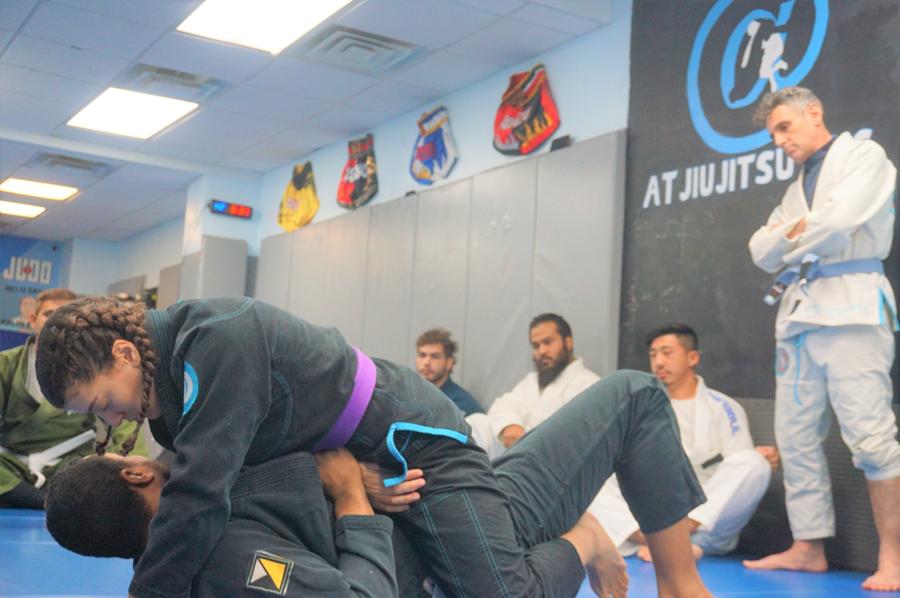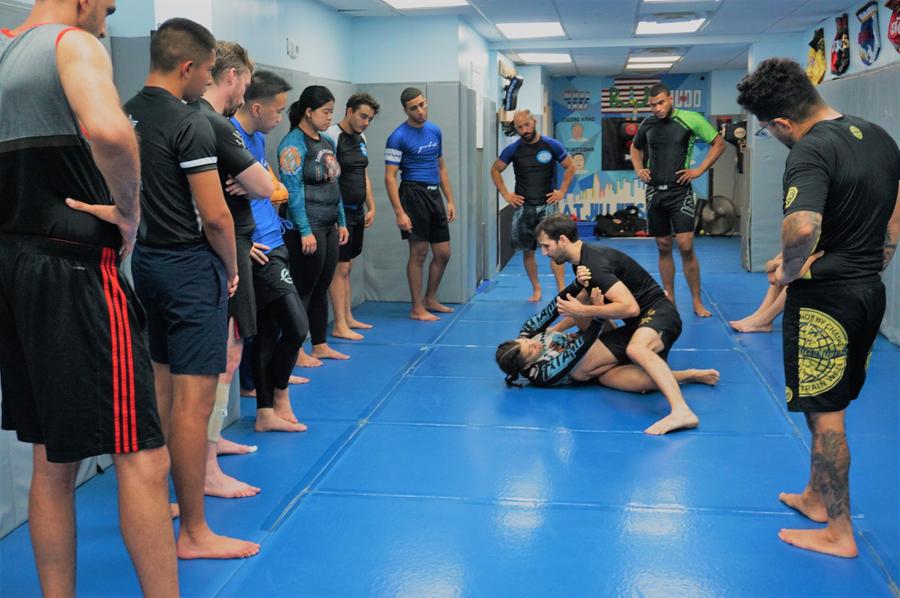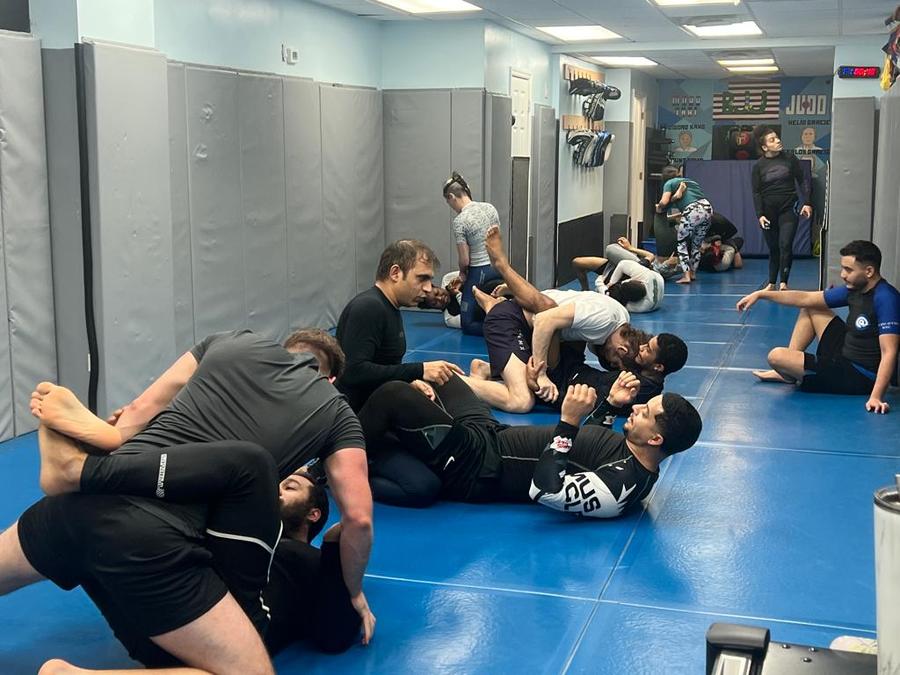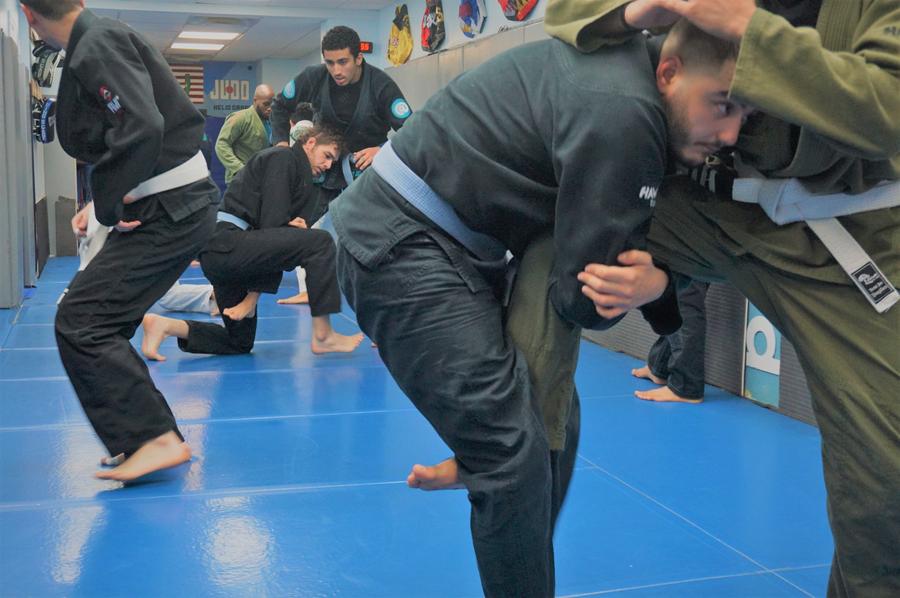Brazilian Jiu-Jitsu
Discover the art of Brazilian Jiu-Jitsu in Jackson Heights, Queens. Dive into BJJ training, from beginner classes to advanced competition training at top academies.
Brazilian Jiu Jitsu
Embark on an incredible journey with Brazilian Jiu-Jitsu, a martial art form that started in Brazil and has now taken the world by storm. Offering a plethora of benefits like self-defense, mental toughness, and fitness, BJJ is more than just a sport. It’s a lifestyle that welcomes individuals of all ages.
What is the influence of martial arts on adults’ well-being
Martial arts is a powerful catalyst that amplifies an adult’s physical agility and bolsters mental fortitude. Embracing this practice not only refines your physique but also sharpens your mental clarity, focus, and confidence. Thinking of embarking on this transformative journey? Dive deeper to understand how martial arts might be the change you’ve been seeking – and consider taking the next step by exploring our sign-up and schedule options.
The best Jiu-Jitsu program in Jackson Heights, NY!
Offering both Gi and No Gi classes.
• We offer a variety of Gi & No Gi classes, Beginners & Advanced classes, and morning, afternoon & evening classes which can fit all schedules!
Beginners No Gi: Mondays 6:15 p.m. - 7:00 p.m.
Beginners Gi: Wednesdays & Fridays 6:15 p.m. - 7:00 p.m.
Advanced Gi: Wednesdays 7:15 p.m. - 8:30 p.m.
Get Started Now:
Register for classes here:
https://www.maonrails.com/signup/member/8s6
Top 10 Perks of Diving into Brazilian Jiu-Jitsu: More Than Just a Sport!
Hey there, future Martial Arts enthusiasts! Ever wondered why Brazilian Jiu-Jitsu (BJJ) is taking the world by storm? Well, it’s not just about the cool moves and Self-Defense skills. There’s a whole lot more to gain, and we’re here to spill the beans! Ready to find out what’s in it for you and your kiddos?
From Friendships to Fitness: The All-Around Benefits of BJJ
- New Besties Alert: The BJJ community is like no other! You’ll bond over the challenges and triumphs, making friends for life.
- Be Your Own Hero: Learn Self-Defense techniques that empower you to handle any sticky situation, from chokes to mounts.
- Say Hello to Your New Fave Hobby: BJJ is a stress-buster and a boredom-killer, all rolled into one!
- Full-Body Workout: Engage your core, legs, and upper body as you master takedowns and submissions. Talk about Fitness goals!
- Cardio King: Boost your endurance and energy levels, making everyday tasks a breeze.
- Shed Those Pounds: With constant movement and muscle engagement, weight loss is a happy side effect.
- Flexibility & Mobility: Improve your range of motion and overall body coordination. No more stiff mornings!
- Mindfulness & Focus: BJJ teaches you to be present and sharpens your Mental Toughness.
- Problem-Solving Skills: Hone your critical thinking as you tackle challenges on the mat, which translates to real-world solutions.
- Just Plain Fun: Last but not least, the joy and smiles on the mat are infectious!
The Amazing Journey of Brazilian Jiu-Jitsu: From Brazil to Your Neighborhood!
Hey there, Martial Arts fans! Ever wondered how Brazilian Jiu-Jitsu became the global sensation it is today? Well, let’s take a quick trip down memory lane. It all started with the Gracie family in Brazil in the early 1900s. Helio Gracie took what he and his family learned from arts like Judo and Japanese Ju-Jitsu and gave it a unique twist. He focused on leverage and ground fighting, making it possible for smaller fighters to hold their own against bigger, stronger opponents. Talk about leveling the playing field!
Why Brazilian Jiu-Jitsu is More Than Just a Sport
Fast forward to today, and Brazilian Jiu-Jitsu is rocking the world! Not only is it a popular sport, but it’s also a go-to for Self-Defense and overall Fitness. Whether you’re looking to boost your Mental Toughness or train for actual combat, BJJ has got you covered. Plus, you’ll find its techniques spicing up other sports like Mixed Martial Arts and Catch Wrestling.
JIUJITSU: Martial Arts FAQ:
Q: How did Brazilian Jiu-Jitsu originate?
A: Brazilian Jiu-Jitsu originated with the Gracie family in Brazil in the early 1900s. Helio Gracie adapted techniques from Judo and Japanese Ju-Jitsu, focusing on leverage and ground fighting.
Q: What are the key benefits of practicing Brazilian Jiu-Jitsu?
A: Brazilian Jiu-Jitsu offers a range of benefits, including self-defense skills, mental toughness, and overall fitness. It also helps in building friendships, improving problem-solving skills, and increasing flexibility and mobility.
Q: Who can benefit from learning Brazilian Jiu-Jitsu?
A: Anyone looking to improve their mental toughness, physical fitness, or self-defense skills can benefit from Brazilian Jiu-Jitsu. It is suitable for both children and adults.
History of Brazilian Jiu-Jitsu: Understanding its roots and evolution over time.
What is the history of Brazilian Jiu-Jitsu?
Originating in the samurai traditions of feudal Japan, the techniques that would evolve into Brazilian Jiu-Jitsu were initially developed to allow an unarmed or lightly armed warrior to defend themselves against a more heavily armed opponent. However, the martial art saw its most significant evolution in Brazil.
When Mitsuyo Maeda, a master of Judo (itself an evolution of Japanese Jujutsu), arrived in Brazil in the early 20th century, he began teaching the Gracie family. The Gracies, especially Hélio Gracie, adapted these techniques to emphasize leverage, enabling a smaller or weaker person to defend against a larger attacker. Over decades, the Gracies refined and developed this system, leading to the birth of Brazilian Jiu-Jitsu as we know it today.
This martial art has since grown in popularity, especially in the late 20th and early 21st centuries, due to its effectiveness in mixed martial arts competitions and its profound self-defense capabilities.
Benefits of Practicing BJJ: Highlighting the physical, mental, and spiritual benefits.
Why should one practice Brazilian Jiu-Jitsu?
Physical Benefits: Brazilian Jiu-Jitsu provides an intense full-body workout. Training sessions involve both strength training and cardiovascular conditioning, leading to improved muscle tone, endurance, and flexibility. The dynamic movements and techniques ensure that all muscle groups get engaged.
Mental Benefits: BJJ challenges the mind just as much as the body. As practitioners advance, they learn to strategize during sparring, predicting opponents’ moves and planning several steps ahead. This martial art also fosters resilience, as students learn to persevere through challenging situations and continually adapt.
Spiritual Benefits: Many find a deep sense of inner peace and fulfillment through Brazilian Jiu-Jitsu. The discipline and respect cultivated in the dojo often translate to personal life, promoting a balanced and harmonious lifestyle. Furthermore, the communal aspect of training—building bonds with training partners and instructors—provides a sense of belonging and purpose.
BJJ Belt Ranking System: Explaining the journey from white belt to black belt.
How does the Brazilian Jiu-Jitsu belt system work?
The BJJ belt system serves as a roadmap for students, marking their progress and achievements in the martial art:
- White Belt: The starting point for all BJJ practitioners. Here, students learn the foundational techniques and principles of the martial art.
- Blue Belt: With a solid understanding of the basics, blue belts begin to spar more intensively, refining their techniques and starting to develop their unique style or “game.”
- Purple Belt: At this intermediate level, students have a comprehensive understanding of BJJ techniques. They are often encouraged to start teaching lower belts, further solidifying their knowledge.
- Brown Belt: Brown belts have a deep understanding of BJJ intricacies and have usually developed a specific set of techniques they’re particularly skilled at.
- Black Belt: A symbol of mastery and dedication, achieving a black belt in BJJ is no small feat. Black belts have a profound understanding of the art and often contribute back to the community by teaching or even opening their own schools.
Beyond the black belt, there are additional degrees, recognizing decades of dedication and contributions to the BJJ community.
Safety Tips for BJJ Practitioners: Discussing how to minimize injuries during training.
How can Brazilian Jiu-Jitsu practitioners ensure safety during training?
Proper Warm-Up: Before engaging in any BJJ session, it’s vital to warm up adequately. This increases blood flow, prepares the muscles for intense activity, and helps prevent strain-related injuries.
Knowledge of Limits: Understanding and respecting one’s limits is crucial. While pushing boundaries is a part of growth, overextending can lead to injuries. It’s essential to listen to your body and rest when needed.
Tapping Out: In BJJ, “tapping out” is a signal to the opponent to release a submission hold. It’s a safety mechanism to prevent injuries. Practitioners should not let pride get in the way; it’s always better to tap out and learn than to get injured.
Regular Gi and Mat Cleaning: A clean gi (uniform) and training mat prevent bacterial and fungal infections. Ensuring hygiene is a shared responsibility in the dojo.
Wearing Protective Gear: Using mouth guards, knee pads, and ear protectors can help avoid common injuries like cauliflower ear or dental injuries.
Stay Hydrated: Dehydration can lead to muscle cramps and fatigue. Drink water before, during, and after training to stay hydrated.
MMA and BJJ: The role of Brazilian Jiu-Jitsu in mixed martial arts competitions.
How has Brazilian Jiu-Jitsu impacted mixed martial arts (MMA)?
Brazilian Jiu-Jitsu has become an integral part of MMA training due to its effectiveness in ground combat. The first Ultimate Fighting Championship (UFC) events, where Royce Gracie, a BJJ practitioner, dominated opponents with various martial arts backgrounds, showcased BJJ’s efficiency.
BJJ offers MMA fighters tools for takedowns, defense against strikes on the ground, and submission techniques to finish fights. Additionally, BJJ’s emphasis on positional control allows fighters to dominate their opponents on the ground, scoring points in judged contests or seeking opportunities to land strikes or submissions.
In modern MMA, knowledge of BJJ is almost mandatory, as ground combat is a significant aspect of the sport. Many champions in MMA attribute a large part of their success to their BJJ training.
Kids and BJJ: The advantages of introducing children to the martial art.
Why should children learn Brazilian Jiu-Jitsu?
Physical Fitness: In an age where many kids are becoming increasingly sedentary, BJJ offers a fun and engaging way to stay active, promoting cardiovascular health, strength, and flexibility.
Discipline and Respect: Martial arts, including BJJ, instill a sense of discipline in children. They learn the importance of consistency, hard work, and respect for instructors and peers.
Self-Defense: While we hope children never have to defend themselves, BJJ provides them with practical self-defense skills. This not only equips them physically but also boosts their confidence.
Problem-Solving Skills: BJJ is often likened to chess; it’s as much a mental game as it is physical. Children learn to think strategically, enhancing their problem-solving skills.
Social Skills: Training in a communal environment helps children develop social skills. They learn teamwork, communication, and even form lasting friendships.
Building Confidence: Achieving new belts and mastering techniques boosts a child’s confidence and self-esteem, helping them face other challenges in life with a positive attitude.
Women’s Brazilian Jiu-Jitsu: Discussing classes specifically tailored for women.
Why are there specialized Brazilian Jiu-Jitsu classes for women?
Tailored Training Environment: While the techniques of BJJ remain consistent across genders, women’s classes often provide an environment where participants might feel more comfortable, especially when starting out. These classes can be more accommodating to the unique concerns women might have, such as specific self-defense scenarios.
Focused Self-Defense Techniques: Women’s BJJ classes often place a particular emphasis on self-defense techniques that address common threats women might face, teaching them how to leverage their strength against a potentially stronger opponent.
Community and Support: Training with other women can foster a sense of camaraderie and mutual support. This community aspect can be empowering, helping to retain more women in the sport.
Physical and Mental Empowerment: Beyond self-defense, women’s BJJ classes promote physical fitness, mental resilience, and confidence—empowering participants in all facets of life.
BJJ Tournaments: Introduction to competition levels and events in Jackson Heights or nearby regions.
What are Brazilian Jiu-Jitsu tournaments, and what can one expect in and around Jackson Heights?
BJJ tournaments allow practitioners to test their skills against others in a controlled environment. They’re structured based on weight classes, age, and belt rank to ensure fair competition.
Competition Levels:
- Local Tournaments: These are smaller events, often held within a city or region. For Jackson Heights, local tournaments might be organized within Queens or neighboring boroughs.
- State or National Championships: Larger in scale, these events attract competitors from across the state or country.
- International Championships: The most prestigious events, like the World Jiu-Jitsu Championship, see competitors from around the globe.
In and around Jackson Heights, one might find local academies hosting open mats or in-house tournaments. Larger events might be held in sports arenas or convention centers in NYC, given its stature as a major city.
Equipment and Gear: Recommended attire and gear for Brazilian Jiu-Jitsu training.
What gear is essential for Brazilian Jiu-Jitsu training?
Gi: The traditional uniform for BJJ, a Gi consists of a heavy cotton jacket, pants, and a belt indicating rank. Some schools might also offer No-Gi classes, where participants wear rash guards and grappling shorts.
Belt: The color represents the practitioner’s rank, and it’s an essential part of the Gi.
Mouth Guard: To protect the teeth and prevent biting the tongue or lips during sparring.
Rash Guard: Worn under the Gi or as the primary upper body garment in No-Gi classes, rash guards help reduce friction burns and protect against mat-borne infections.
Grappling Shorts or Spats: Used in No-Gi classes, these tight-fitting shorts or pants prevent snags and provide a range of motion.
Ear Guards: Optional but recommended for those who want to prevent “cauliflower ear,” a common injury resulting from friction or trauma to the ear.
Knee Pads: Helpful for those with sensitive knees, as BJJ involves a lot of groundwork.
Duffel Bag: A spacious bag to carry all gear, preferably with compartments for wet or sweaty items.
For those just starting, it’s advisable to check with the academy on their specific attire requirements before making any purchases.

